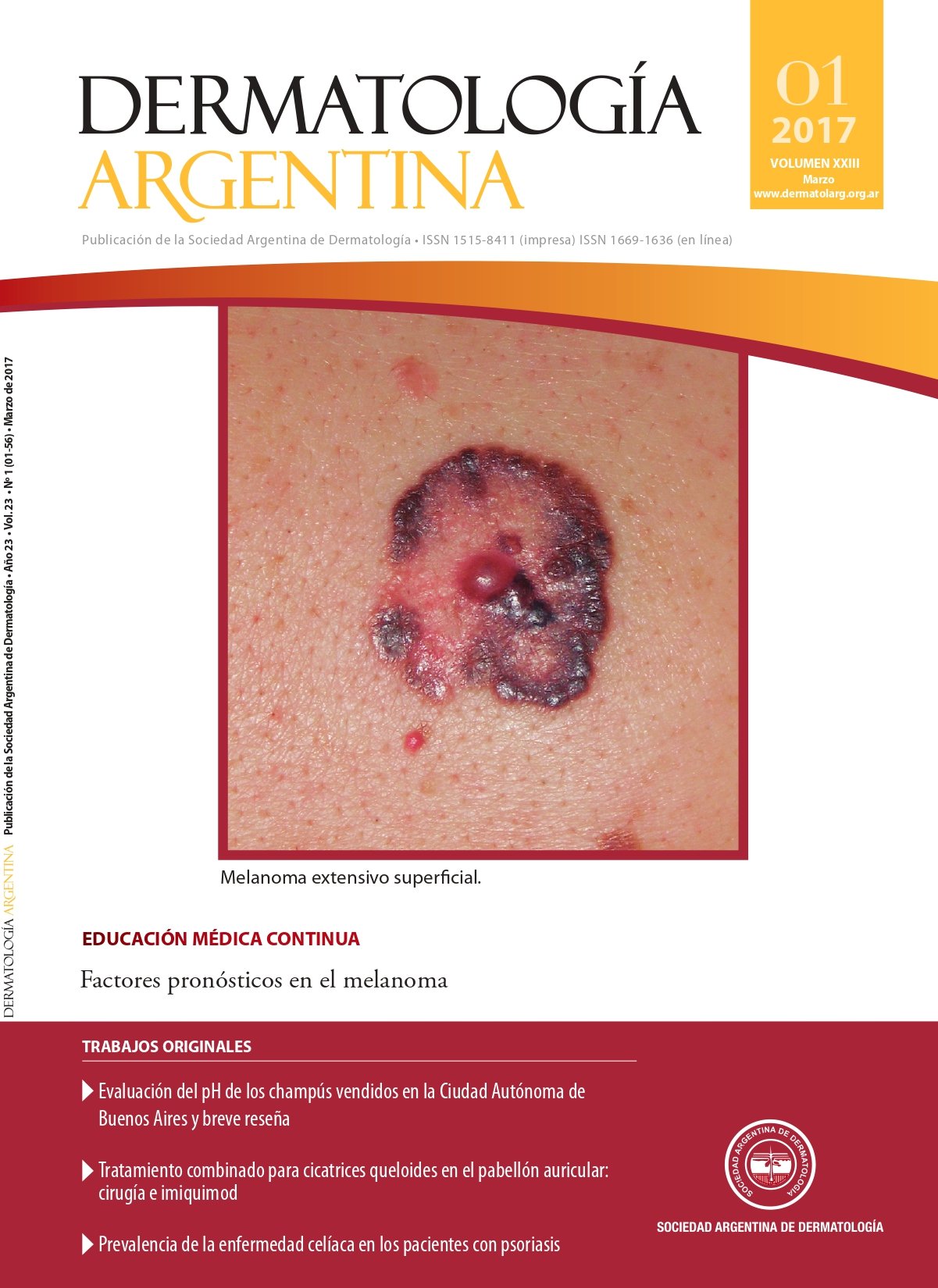Factores pronósticoa en el melanoma
Palabras clave:
sobrevida, factores pronósticos, melanomaResumen
En los últimos cincuenta años se han estudiado distintos factores pronósticos en el melanoma. La versión publicada en 2009 por el American Joint Committee on Cancer (AJCC) incluye el espesor tumoral (Breslow), la ulceración, el número de mitosis, la presencia o no de microsatelitosis, el compromiso ganglionar y la presencia de metástasis a distancia como principales factores pronósticos. Sin embargo, en determinados casos no está claro qué es lo que lleva a que el melanoma sea invasor y acarree la muerte. El propósito de este trabajo es realizar una revisión bibliográficaacerca de los distintos factores pronósticos conocidos en el melanoma introduciendo la genética en este ámbito.
Citas
I. Perdue MP, From L, Armstrong BK, Kricker A, et ál. Etiologic and other factors predicting nevus-associated cutaneous malignant melanoma. Cancer Epidemiol Biomarkers Prev2005;14:2015-2022.
II. Göppner D, Leverkus M. Prognosticparameters for the pri-mary care of melanoma patients: what is really risky in mela-noma? J Skin Cancer 2011;3:1155-1168.
III. Blach CM, Gershenwald JE, Soong S, Thomson JF, et ál. Final Version 2009 AJCC Melanoma Staging and Classification. J Clin Oncol 2009;27:6199-6206.
IV. Rogers GS, Braun SM. Prognostic factors. Dermatol Clin2002;20:647-658.
V. Casanova JM, Martí Laborda RM, Bardad M. Estadificación y pronóstico del melanoma. Piel 2005;20:133-140.
VI. MacKie RM, Bray CA, Hole DJ, Morris A, et ál. Incidence of and survival from malignant melanoma in Scotland: an epidemio-logy study. Lancet 2002;360:587-591.
VII. Meyskens FL, Berdeaux BH, Parks B, Tong T, et ál. Cutaneous malignant melanoma: Natural history and prognostic factors influencing survival in patients with Stage I disease. Cancer1988;62:1207-1214.
VIII. O’Doherty CJ, Prescott RJ, White H, Mclntyre M, et ál. Sex di-fferences in presentation of cutaneous malignant melanoma and in survival from stage I disease. Cancer 1986;58:788-792. 9
IX. Tejera-Vaquerizo A, Solís García E, Ríos Martin JJ, Moreno-Ra-mírez D. Factores pronósticos en el melanoma cutáneo prima-rio no incluidos en la clasificación del American Joint Commi-ttee on Cancer. Actas Dermosifilogr 2011;102:255-263. 10. Miller JG, Mac Neil S. Gender and cutaneous melanoma. Br J Dermatol 1997;136:657-665.
XI. Lasithiotakis K, Leiter U, Meier F, Eigentler T, et ál. Age and gender are significant independent predictors of survival in primary cutaneous melanoma. Cancer 2008;112:1705-1804.
XII. Messaris GE, Konstadoulakis MM, Ricaniadis N, Leandros E, et ál. Prognostic variables for patients with stage III malignant melanoma. Eur J Surg 2000;166:233-239.
XIII. Balch CM, Soong S, Roos MI, Urist MM, et ál. Long-term results of a multi-institutional randomized trial comparing prognos-tic factors and surgical results for intermediate thickness me-lanomas. Ann Surg Oncol 2000;7: 87-97.
XIV. Oliveria SA, Christos PJ, Halpern AC, Fine JA, et ál. Evaluation of factors associated with skin self-examination. Cancer Epide-miol Biomarkers Prev 1999;8:971-978.
XV. Christos PJ, Oliveria SA, Berwick M, Guerry D 4th, et ál. Signs and symptoms of melanoma in older populations. J Clin Epidemiol2000;53:1044-1053.
XVI. Balch CM, Soong S, Gershenwald JE, Thompson JF, et ál. Prog-nostic factors analysis of 17,600 melanoma patients: valida-tion of the American Joint Committee on Cancer Melanoma Staging System. J Clin Oncol 2001;19:3622-3634.
XVII. Yaar M, Gilchrest B. Melanoma. En: Bolonga JN, Jorizzo JL, Schaffer JV, Callen JP, Cerroni L, eds. Dermatology, 3.ª ed., Else-vier, 2012:1792-1802.
XVIII. Schuchter L, Shultz DJ, Synnestvedt M, Trock BJ, et ál. A prog-nostic model for predicting 10-year survival in patients with primary melanoma. Ann Intern Med 1996;125:369-375.
XIX. Gillgren P, Mansson-Brahme E, Frisell J, Johansson H,et ál. A prospective population-based study of cutaneous ma-lignant melanoma of the head and neck. Laryngoscope2000;110:1498-1504.
XX. Lachiewicz M, Berwick M, Wiggins CL, Thomas NE. Survival differences between patients with scalp or neck melano-ma and those with melanoma of other sites. Arch Dermatol2008;144:515-521.
XXI. Breslow A. Thickness cross-sectional areas and depth of in-vasion in the prognosis of cutaneous melanoma. Ann Surg1970;172:902-908.
XXII. Balch CM, Buzaid AC, Soong SJ, Atkins MB, et ál. Final version of the American Joint Committee on Cancer staging system for cutaneous melanoma. J Clin Oncol 2001;19:3635-3648.
XXIII. Balch CM, Murad TM, Soong SJ, Ingalls AL, et ál. A multifac-torial analysis of melanoma: Prognostic histophatological fea-tures comparing Clark’s and Breslow’s staging methods. Ann Surg 1978;188:732-742.
XXIV. Paek SC, Griffith KA, Johnson TM, Sondak VK, et ál. The impact of factors beyond breslow depth on predicting sentinel lymph node positivity in melanoma. Cancer 2007;109:100-108.
XXV. Kunte C, Geimer T, Baumert J, Konz B, et ál. Analysis of predictive factors for the outcome of complete lymph node dissection in melanoma patients with metastatic sentinel lymph nodes. J Am Acad Dermatol 2011;64:655-662.
XXVI. Rivers JK, Ho VC. Malignant melanoma. Who shall live and who shall die? Arch Dermatol 1992;128:537-542.
XXVII. Allen AC, Spitz S. Malignant melanoma; a clinicopathological analysis of the criteria for diagnosis and prognosis. Cancer1953;6:1-45.
XXVIII. Balch CM, Wilkerson JA, Murad TM, Soong SJ, et ál. The prog-nostic significance of ulceration of cutaneous melanoma. Can-cer 1980;45:3012-3017.
XXIX. Yaar M, Gilchrest B. Melanoma. En: Fitzpatrick TB, Freedberg IM, Eisen AZ, et ál.Dermatología en Medicina General. Buenos Aires: Editorial Médica Panamericana, 2009:1792-1802.
XXX. Kalady MF, White RR, Johnson JL, Tyler DS, et ál. Thin melano-mas: predictive lethal characteristics from 30-year clinical ex-perience. Ann Surg 2003;238:528-537.
XXXI. Göppner D, Ulrich J, Pokrywka A, Peters B, et ál. Sentinel lymph node biopsy status is a key parameter to stratify the prognostic heterogeneity of malignant melanoma in a high-risk tumors >4.0 mm. Dermatology 2011;222:59-66.
XXXII. Clark WH Jr, Elder DE, Guerry D 4th, Braitman LE, et ál. Model predicting survival in stage I melanoma based on tumor pro-gression. J Natl Cancer Inst 1989;81:1893-1904.
XXXIII. Attis MG, Vollmer RT. Mitotic rate in melanoma. Am J Clin Pa-thol 2007;127:380-384.
XXXIV. Thompson JF, Soong SJ, Balch CM, Gershenwald JE, et ál.Prognostic significance of mitotic rate in localized primary cutaneous melanoma: an analysis of patients in the multi-ins-titutional American Joint Committee on Cancer melanoma staging database. J Clin Oncol 2011;29:2199-2205.
XXXV. Francken AB, Shaw HM, Thompson JF, Soong SJ, et ál. The prognostic importance of tumor mitotic rate confirmed in 1,317 patients with primary cutaneous melanoma and long follow-up. Ann Sug Oncol 2004;11:426-433.
XXXVI. Azzola MF, Shaw HM, Thompson JF, Soong SJ, et ál. Tumor mitotic rate is a more powerful prognostic indicator than ulceration in patients with primary cutaneous melanoma: An analysis of 3661 patients from a single center. Cancer2003;97:1488-1498.
XXXVII. Barnhill RL, Katzen J, Spatz A, Fine J, et ál. The importance of mitotic rate as a prognostic factor for localized cutaneous me-lanoma. J Cutan Pathol 2005;32:268-273.
XXXVIII. Blessing K, Mc Klaren KM. Histologic regression in primary cu-taneous melanoma: recognition, prevalence and significance. Histopathology 1992;20:315-322.
XXXIX. Ronan SG, Eng AM, Briele HA, Shioura NN, et ál. Thin malignant melanomas with regression and metastases. Arch Dermatol1987;123:1326-1330.
XL. Blessing K, McLaren KM, McLean A, Davidson P. Thin malignant melanomas with metastases: a histological study and survival analysis. Histophatology 1990;17:389-395.
XLI. Botella-Estrada R, Traves V, Requena C, Guillen-Barona C, et ál.Correlation of histologic regression in primary melanoma with sentinel node status. JAMA Dermatol 2014; 150;828-835.
XLII. Gershenwald JE, Thompson W, Mansfield PF, Lee JE, et ál. Mul-ti-institutional melanoma lymphatic mapping experience: the prognostic value of sentinel lymph node status in 612 stage I or II melanoma patients. J Clin Oncol 1999;17:976-983.
XLIII. Morton DL, Thompson JF, Cochran AJ, Mozzillo N, et ál. Final trial report of sentinel-node biopsy versus nodal observation in melanoma. N Engl J Med 2014;370:599-609.
XLIV. Day CL, Harrist TJ, Gorstein F, Sober AJ, et ál. Malignant me-lanoma. Prognostic significance of ‘‘microscopic satellites’’ in the reticular dermis and subcutaneous flat. Ann Surg1981;194:108-112.
XLV. Greenstein DM, Rogers GS. Advances in the diagnosis and treatment of melanoma. Dermatol Surg Oncol 1991;21:919-926.
XLVI. Kimsey TF, Cohen T, Patel A, Busam KJ, et ál. Microscopic sate-llitosis in patients with primary cutaneous melanoma: impli-cations for nodal basin staging. Ann Surg Oncol 2009;16:1176-1183.
XLVII. Nagore E, Requena C, Traves V, Guillen C, et ál. Prognostic va-lue of BRAF mutations in localized cutaneous melanoma. J Am Acad Dermatol 2014;70:858-862.
XLVIII. Flaherty KT, Robert C, Hersey P, Nathan P, et ál. Improved survi-val with MEK inhibition in BRAF-mutated melanoma. N Engl J Med 2012;367:107-114.
XLIX. Bucheit AD, Syklawer E, Jakob J, Bassett RL Jr, et ál. Clinical characteristics and outcomes with specific BRAF and NRAS mutations in patients with metastatic melanoma. Cancer2013;119:3821-3829.
L. Menzies AM, Haydu LE, Visintin L, Carlino MS, et ál. Distingui-shing clinicopathologic features of patients with V600E and V600K BRAF mutant metastatic melanoma. Clin Cancer Res2012;18:3242-3249
Descargas
Publicado
Número
Sección
Licencia
Derechos de autor 2017 Sociedad Argentina de Dermatología

Esta obra está bajo una licencia internacional Creative Commons Atribución-NoComercial-SinDerivadas 4.0.
El/los autor/es tranfieren todos los derechos de autor del manuscrito arriba mencionado a Dermatología Argentina en el caso de que el trabajo sea publicado. El/los autor/es declaran que el artículo es original, que no infringe ningún derecho de propiedad intelectual u otros derechos de terceros, que no se encuentra bajo consideración de otra revista y que no ha sido previamente publicado.
Le solicitamos haga click aquí para imprimir, firmar y enviar por correo postal la transferencia de los derechos de autor













